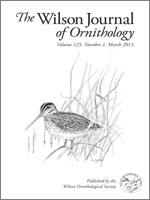We observed a pair of Belted Kingfishers (Megaceryle alcyon) as they initiated burrow excavation in a bank along Rattlesnake Creek near Missoula, Montana in April 2010. During 180 min of observation on the first three mornings (17–19 Apr) of burrow excavation we observed the kingfishers fly rapidly at the bank from perched or hovering distances of 1–3 m and strike the bank bill-first 176 times, forming a pit in the vertical bank about body-deep after 60 hrs of work. Both sexes performed aerial ramming, at roughly the same rate. On the fourth morning we saw no ramming during 40 min of observation while excavation continued, but the site was abandoned later in the day. Aerial ramming at the start of burrow excavation appeared necessary because (1) the bank was vertical to overhanging without exposed roots, providing no opportunity for the birds to perch at the excavation site when beginning to dig, and (2) the birds seemed unable to strike the substrate with sufficient force to promote excavation while perched on the bank or hovering at the burrow entrance until several days into excavation, perhaps due to the presence of imbedded gravel and cobble in the soil. At least 13 species of kingfishers in the subfamilies Alcedininae and Daceloninae are reported to aerial ram into potential burrow sites (banks, termitaria, trees). Ours appears to be the first report of aerial ramming by the Belted Kingfisher and a member of the subfamily Cerylinae.
How to translate text using browser tools
1 March 2013
Aerial Ramming, a Burrow Excavation Behavior by Belted Kingfishers, with a Review of its Occurrence among the Alcedinidae
Paul Hendricks,
Deborah Richie,
Lisa M. Hendricks
ACCESS THE FULL ARTICLE
aerial ramming
Alcedinidae
behavior
Belted Kingfisher
burrows
Megaceryle alcyon
nesting





